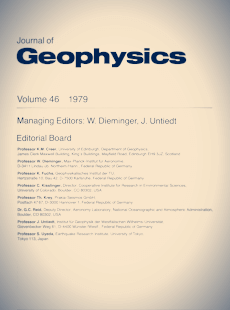Age and crustal structure of the Canary Islands
Article Sidebar

Vols. 1-18 (1924-1944), ISSN 0044-2801
Main Article Content
Abstract
The postulation of a Mesozoic age for the shield-building basaltic series of Gran Canaria and Tenerife by Storevedt et al. (1978), based upon paleomagnetic data from these islands, is inconsistent with abundant and concordant K/Ar-ages from several laboratories. These latter data leave no doubt that no rocks older than Mid-Miocene have been found on Gran Canaria and Tenerife. Moreover, no volcaniclastic layers older than Miocene were found in Deep Sea Drilling cores near the Canary Islands. Also, the volcanic apron around at least Gran Canaria appears to be Miocene in age judging from seismic reflectors that extend to well-dated drilled sections. There is no evidence for a sialic crustal layer extending beneath all or any of the Canary Islands.
 ARK: https://n2t.net/ark:/88439/y002516
ARK: https://n2t.net/ark:/88439/y002516
Permalink: https://geophysicsjournal.com/article/283
Article Details
References
Abdel-Monem, A., Watkins, N.D., Gast, P.W. (1972) Potassium-argon ages, volcanic stratigraphy, and geomagnetic polarity history of the Canary Islands: Tenerife, La Palma and Hierro. Am. J. Sci. 272:805-825
Beck, R.H., Lehner, P. (1974) Oceans, new frontier in exploration. Am. Assoc. Petrol. Geol. Bull. 58:376-395
Dash, B.P., Bosshard, E. (1968) Crustal studies around the Canary Islands. Prague: Proc. 23rd Intern. Geol. Congr. 1:249-260
Dietz, R.S., Sproll, W.P. (1970) East Canary Islands as a microcontinent within the Africa-North America continental drift fit. Nature 266:1043-1945
Fuster, J.M., Hernandez-Pacheco, A., Munoz, H., Peoriques Badiola, E., Garcia Cacho, L. (1968) Geologia y volcanologia de las Islas Canarias-Gran Canaria. Madrid: Consejo Sup. Investig. Cient. 243 pp.
Fuster, J.M., Paez, A., Sagredo, J. (1970) Significance of basic and ultramafic rock inclusions in the basalts of the Canary Islands. Bull Volcanol. 33:665-691
Grunau, H.R., Lehner, P., Cleintuar, M.R., Allenbach, P., Bakker, G. (1975) New radiometric ages and seismic data from Fuerteventura (Canary Islands), Maio (Cape Verde Islands) and Sao Tome (Gulf of Guinea). In: Borradaille, G.J. et al. (Eds.) Progress in geodynamics, pp. 90-1I8. Amsterdam: Koninkl. Nederl. Akad. Wetensch.
Hernan Reguera, F. (1976) Estudio petrol6gico y estructural del complejo traquiticosienitico de Gran Canaria. Estud. Geol. Madrid 32:279-324
Lancelot, Y., Seibold, E. (1977) Initial Reports of the Deep Sea Drilling Project. Vol. 41, p. 1259. U.S. Government Printing Office, Washington
Lehner, P., Ruiter, P.A.C. de (1977) Structural history of Atlantic margin of Africa. Am. Assoc. Petrol. Geol. Bull. 61:961-981
Lietz, J., Schmincke, H.-U. (1975) Miocene-Pliocene sea-level changes and volcanic phases on Gran Can aria (Canary Islands) in the light of new K/ Ar-ages. Palaeogeogr. Palaeoclimatol. Palaeoecol.
18:213-239
McDougall, I., Schmincke, H.-U. (1976) Geochronology of Gran Canary, Canary Islands: Age of shield building volcanism and other magmatic phases. Bull. Volcanol. 40:1-21
Robertson, A.H.F., Stillman, C.J. (1979) Submarine volcanic and associated sedimentary rocks of the Fuerteventura Basal Complex, Canary Islands. Geol. Mag. 116:203-214
Rona, P., Nalwalk, A.J. (1970) Post-early Pliocene unconformity on Fuerteventura, Canary Islands. Geol. Soc. Am. Bull. 81:2117-2122
Rothe, P., Schmincke, H.-U. (1968) Contrasting origins of the eastern and western islands of the Canarian Archipelago. Nature 218:1152-1154
Schmincke, H.-U. (1967) Cone sheet swarm, resurgence of Tejeda Caldera, and the early geologic history of Gran Canaria. Bull. Volcanol. 31:153-162
Schmincke, H.-U. (1968) Faulting versus erosion and the reconstruction of the Mid-Miocene shield volcano of Gran Canaria. Geol. Mitt. 8:23-50
Schmincke, H.-U. (1976) The geology of the Canary Islands. In: Kunkel, G. (Ed.) Biogeography and Ecology in the Canary Islands, Junk, the Hague, pp. 67-184
Schmincke, H.-U., Rad, U. v. (1979) Neogene evolution of Canary Island volcanism inferred from ash layers and volcaniclastic sandstones of DSDP site 397 (Leg 47 A). In: Rad, U.v. et al. (Eds.) Initial Reports of the Deep Sea Drilling, Project. Vol. 47(1), U.S. Government Printing Office, Washington
Schmincke, H.-U., Staudigel, H. (1976) Pillow lavas on central and eastern Atlantic Islands (La Palma, Gran Canaria, Porto Santo, Santa Maria) (preliminary report). Bull. Soc. Geol. Fr. 18:871-883
Stillman, C.J., Fuster, J.M., Bennell-Baker, M.J., Munoz, M., Smewing, J.D., Sagredo, J. (1975) Basal complex of Fuerteventura (Canary Islands) is an oceanic intrusive complex with rift-system affinities. Nature 257:469-471
Storetvedt, U.M., Sralestad, S., Thomassen, K., Langlie, Aa., Nergard, A., Gidskehaug, A. (1978) Magnetic discordance in Gran Canaria/Tenerife and its possible relevance to the formation of the N.W. African continental margin. J. Geophys. 44:317-332
Uchupi, E., Emery, K.O., Bowin, C.O., Philipps, J.D. (1976) Continental margin off Western Africa: Senegal to Portugal, AAPG Bull. 60(5):809-878
Watkins, N.D. (1973) Palaeomagnetism of the Canary islands and Madeira. Geophys. J. R. Astron. Soc. 32:249-267
Watkins, J.S., Hoppe, K.W. (1978) Reconaissance geology of Atlantic Margin of NW Africa, 25°-34°N. Second Maurice Ewing Memorial Symposium on 'Implications of Deep Sea Drilling Results in the North Atlantic', New York, March 22-25
Weigel, E., Goldflam, P., Hinz, K. (1978) The crustal structure of Concepcion Bank. Marine Geophys. Res. 3:381-392
Wissmann, F., Hinz, K., Weigel, W. (1977) Geophysical evidence for the nature of the continent-ocean boundary off northwest Africa. Abstract. Royal Society Meeting October, London 19-20











